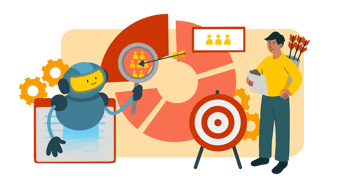Gérer le passage des ventes à la réussite des clients
L'un des principaux points de friction dans le monde des affaires est le transfert des clients entre l'équipe de vente et l'équipe chargée de la réussite des clients. Ce transfert comprend l'expérience d'un client qui passe de l'avant-vente à l'après-vente, puis à la mise en œuvre. Comment éviter ces frictions ?

Avant d'aborder la question de la résolution de ce problème, examinons-le plus en détail. Lorsque le principal point de contact d'un client passe d'une personne à l'autre, il entre dans la zone de danger. La zone de danger, c'est lorsqu'un défenseur du client commence à oublier des détails essentiels concernant le client, tels que les termes d'un accord ou l'idée qu'il se fait d'un succès mutuel. L'entrée dans la zone dangereuse est problématique pour diverses raisons. La perte d'informations vitales entre les membres d'une équipe crée des tensions et fait perdre du temps. Si le transfert de connaissances échoue, les clients doivent se répéter et des attentes essentielles peuvent être perdues ou mal communiquées.
Ces dilemmes augmentent le rapport temps/valeur d'un client, c'est-à-dire le temps nécessaire pour percevoir la valeur du produit ou du service acheté. Chaque fois qu'un client est contraint de revoir ses attentes, il lui faut plus de temps pour réussir dans ce processus. La relation entre le temps et la valeur est inverse, ce qui signifie que plus le temps est long, moins le client a l'impression d'être satisfait, et vice versa. En tant qu'organisation, vous devez vous efforcer de maintenir le rapport temps/valeur des clients aussi bas que possible, en respectant à la fois votre temps et le leur. Les transferts entre les représentants peuvent faire ou défaire ce ratio, c'est pourquoi ils doivent être fluides et sans heurts.
Alors, pourquoi est-il si important de démontrer la réussite aux clients qui ont déjà effectué un achat ? Les clients qui constatent un manque de réussite dans le processus de vente seront moins enclins à renouveler leurs achats à l'avenir. Il est essentiel de prendre soin de vos clients tout au long du processus de vente afin de les transformer en acheteurs réguliers. Non seulement cela transforme vos clients en promoteurs, encourageant d'autres personnes à acheter chez vous, mais cela permet également à votre entreprise d'économiser du temps et de l'argent. Il est vingt-cinq fois plus coûteux d'acquérir un nouveau client que de conserver un client existant ; la fidélisation de la clientèle est donc vitale.
Maintenant que vous comprenez l'importance d'un transfert de clientèle réussi, nous allons voir comment éviter les frictions. La plupart des conflits surviennent lorsqu'un client passe d'un point de contact principal à un autre, le plus souvent entre l'équipe de vente et l'équipe chargée du suivi de la clientèle. Si la plupart des frictions se produisent à ce moment-là, elles ne sont pas nécessairement imputables à l'un ou l'autre des points de contact. Un client peut oublier ce qui a été dit ou changer d'avis au cours des étapes du succès. Néanmoins, il incombe aux représentants de l'entreprise de veiller à ce que les transitions se fassent en douceur et à ce que les clients soient satisfaits.
Le moyen le plus efficace d'assurer une transition en douceur et réussie est de créer un manuel de transition entre les ventes et la réussite du client. Ce guide en cinq étapes fournit aux entreprises les moyens d'ouvrir la communication entre les équipes et de trouver la méthode qui convient le mieux à leur organisation et à leurs clients.
1. Objectifs
- Formulez des objectifs clairs pour les équipes chargées des ventes et du succès des clients.
- Aligner les objectifs des deux équipes.
- Utiliser la même mesure du succès pour permettre la comparaison (par exemple, le taux de fidélisation de la clientèle).
2. Système de copinage
- Associer des membres du service commercial à des membres du service clientèle.
- Créer une relation interfonctionnelle significative.
- Améliore et ouvre la communication.
- Favorise l'empathie.
- Fournir à chaque membre de l'équipe un point de contact dans l'autre équipe.
- Fournir des exemples de questions pour ouvrir la discussion :
- Quelle est la partie la plus difficile de votre travail ?
- Comment mon équipe peut-elle mieux aider la vôtre ?
- Quels sont les problèmes les plus importants que votre équipe tente de résoudre ?
- Organisez des réunions régulières entre les copains (virtuelles ou en personne).
3. Modèles de notes
- Modèles prédéfinis que les membres d'une équipe peuvent remplir pour transmettre des informations précises à une autre équipe.
- Inclure : le principal point de contact, la raison de l'achat, le calendrier, les éléments à connaître et les objectifs.
- Favorise une communication claire.
- Le modèle doit être aussi facile à utiliser que possible pour inciter les vendeurs à l'utiliser et ne pas prendre trop de temps.
- Les notes descriptives permettent d'éviter les répétitions inutiles.
- Demandez aux employés chargés du suivi de la clientèle de prendre des notes à la fin du processus afin de les comparer avec celles de l'équipe de vente et de les utiliser lors d'achats futurs.
4. Retour d'information
- Modèle Situation, Comportement, Impact (SBI)
- Modèle permettant de fournir un retour d'information utile et objectif en se concentrant sur des situations spécifiques et en décrivant l'impact de ces comportements sur les autres.
- Situation: décrire clairement la situation.
- Comportement: discuter du comportement spécifique à traiter.
- Impact: soulignez l'impact de ce comportement sur vous, sur l'équipe et sur l'organisation.
- Dans le cas d'un retour d'information positif ou négatif, prenez contact avec le client et faites-lui savoir que vous l'avez entendu.
- Fournissez à vos collègues un retour d'information exploitable afin de leur donner la possibilité de s'améliorer.
- Au lieu de dire "Tu dois produire plus", suggérez "Je dois trouver un moyen pour que nous soyons plus productifs aujourd'hui, puis-je compter sur toi pour le faire ?
5. Ressources
- Créez une liste des membres de l'équipe.
- Liste des membres des équipes de vente et de suivi de la clientèle et des compétences qu'ils maîtrisent.
- Permettez aux membres de l'équipe de contacter toute personne figurant sur la liste et maîtrisant les compétences dont ils ont besoin.
- Cela ouvre la communication entre les équipes tout en permettant aux autres de développer leurs compétences.
- Encourager les employés à demander de l'aide à leurs collègues plutôt qu'à la direction.
Un cahier des charges personnalisé garantit une communication ouverte entre vos équipes de vente et de service à la clientèle. Vous réduirez ainsi les remords de l'acheteur et augmenterez la fidélisation de la clientèle, transformant vos clients en promoteurs. Bien que ce cahier des charges puisse être différent pour chaque entreprise, il devrait fournir un modèle permettant de définir les objectifs et les attentes de votre entreprise, ainsi que les ressources nécessaires pour les atteindre. En l'intégrant à votre plan de réussite, veillez à ce que toutes les parties concernées comprennent clairement ce qu'il faut faire pour assurer une transition sans heurts entre les ventes et la réussite des clients.
Ce contenu est disponible en:
- Allemand: Management der Übergabe zwischen Vertrieb und Kundenerfolg
- Anglais: Managing Your Sales to Customer Success Handoff
- Espagnol: Gestión del traspaso de ventas a éxito del cliente
- Italien: Gestire il passaggio dalle vendite al successo del cliente
- Roumain: Gestionarea transferului de la vânzări la succesul clientului
- Chinois: 管理销售与客户成功的交接








Commentez ci-dessous